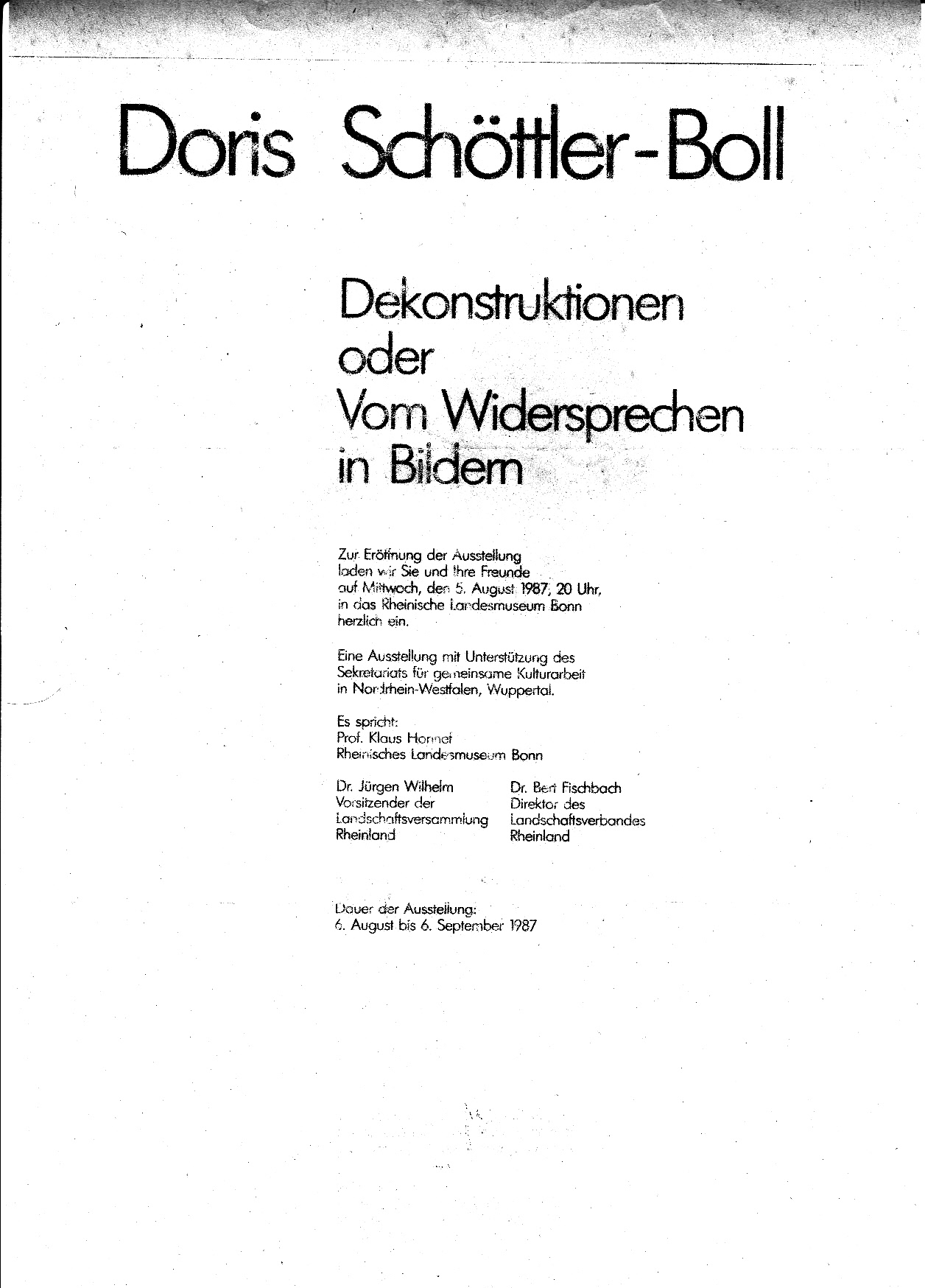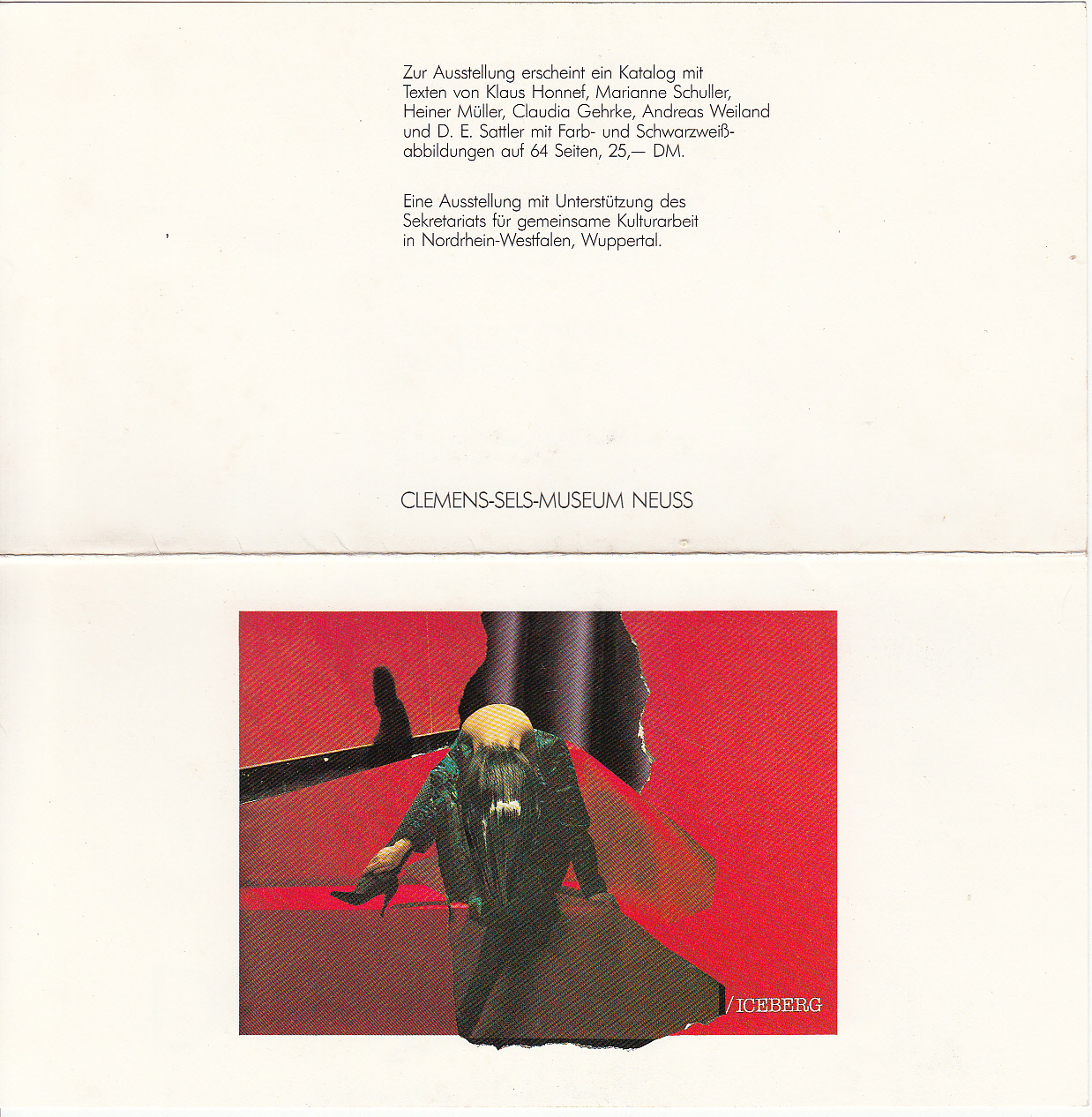| J. Weidenfels
Doris Schöttler-Boll:
Artist of De-Construction
|
"The worlds these images are made of, are images." "Doris Schöttler-Boll
radicalizes the principles of
collage." (Marianne Schuller) |
Doris Schöttler-Boll studied with Joseph Beuys.
Since 1974, she was active as an independent professional artist, in ways
that were what she called "multiperspektivisch," in other words,
entailing a multiplicity of perspectives. She never worked only as a lone,
individual artist, but always inspired "group processes" at the same time.
Beuys wrote about her way of working that it is situated beyond rigid aestheticism
and one-sided 'politicism' ("jenseits von rigidem Ästhetizismus und
einseitigem Politismus") and that it is difficult to value it highly enough.
In the mid-1970s, her stay in Paris and the encounter
with Derrida became significant for her. It was Derrida, to whom she had
written before she was on her way to Paris, that she was compelled to steal
the term deconstruction from him because speaking of her visual art
works as collages/montages was too reductionist and would fail to grasp
the specificity of her way of working. She did not use the term deconstruction
as a philosophical concept but in order to describe her concrete aesthetic
practice. Her 'signet' DE/KON/STRUKTION which emphasizes the procedures
of destruction and construction visually, hints at the tension of the creative
processes which were inherent to the way her visual works originated.
About the difference between her individual work as an
artist and her committed involvement that aimed at a sort of "ART of LIVING"
(LEBENsKUNST") in cooperation "with quite heterogenous groups
of people," she said that in the first instance it turned around something
"beyond calculated concept and pure chance" whereas an idea was always
the starting point for that work which happened in group contexts.
It was possible that an idea was present subconsciously
when she was involved in her own artistist work, but, she said, "in this
respect I agree with Godard: I can only begin to speak about this idea
when I see it [in the realized work]...."
Derrida wrote about her art works that they are fascinating
because they are beautiful and make one think a lot" ("da sie wunderschön
sind und viel zu denken geben").
It was this the artist wanted to achieve again and again:
To "give" the viewer something she or he "can think about."
Stringency, but also beauty.
The trace of thoughts in her works - it is not necessarily
that of rational, logical thinking, She also warned that an artist does
not simply convey thoughts via images. Thoughts are rather present within
the images.

'Deconstructions - or About Contradicting through Images'
Solo Exhibition of Doris Schöttler-Boll, Rhenanian State Museum,
Bonn, Aug. 6 - Sept. 6, 1987
At the bottom of the image, there is again an image, as
Godard said.
Quoting this, she added, When an artist rebels
against that which today is called a "flood of images" and attempts
to resist "by posing questions concerning the dispositifs and causes
[...], this happens also in the context of a search for effects, the causes
of which often remain in the dark." (But, she would add, this is not consciously
present, not - at least - during the work process.)
"First, there is life."
"I open my eyes in the morning
and I don't see a text / I see an image"
In this regard she distanced herself from every emphatic
heightening, every explicit evocation of the subject.
She wrote, with regard to her collage/montage
practice:
"I abstain from all 'subjective traces' such as painterly
or drawn interventions [...]
To establish a new totality - even by way of reference
to the identity of the artist - could diminish the subversion and
the desire and make it harmless. The 'subjective trace' (the subject
effect)
appears only in the act of deconstruction, in the work of difference,
the process of de-identification. Which means also / that this, which can
be seen, is more than mine. Or: Where I was, IT shall be."

Solo Exhibition by Doris Schöttler-Boll, Clemens-Sels Museum
Neuss, Sept. 13 - Oct 18, 1987
Catalogue with texts by Klaus Honnef, Marianne Schuller, Heiner Müller,
Claudia Gehrke, Andreas Weiland
While she stole the term deconstruction from Derrida,
it was also the way Lacan thought that she felt an affinity to; psychoanalysis
always was significant for her. Without illustrating it, she took into
account what Lacan said "What we can betray is only our desire...."
As an artist, she remained aware of the social context,
the situatedness of the artistic process.
Farocki's approach fascinated her because he attempted
not to depart from the subjects but from societal structures which become
the base, the point of departure and the point of reference for visible
forms of behavior.
Like Farocki, she wanted to find (or invent) images
for these relations. Images which make clear which social mechanisms
were causing forms of behavior.
When she succeeded to achieve this, it was never in the
sense of unfractured, naturalistic mirroring.
It was always something subterreanean and in it, tensions
resounded.
This is why D.E. Sattler speaks of the 'in-between' or
the 'interlude' / ZWISCHENZEIT", which resounds in her works: "The depicted
moment never was nor will it be. The same is true of the space: It is and
it is not. We find ourselves thus / which needs urgently an explanation
/ in a special time and a special space, neither within nor entirely
outside space and time. It is the camera obscura by way of which the dream
has nested in the day. The strange location where this is happening
is the interspace (Zwischenraum)."
When artists were asked what their theme are, she wold
answer that the themes of her works originated, if at all, post festum.
She also quoted Pierre Macherey who reminded her, when confronted with
her works, that it was not simply and only the creative process but "the
image itself which is endowed with the quality of an event (das Bild selbst,
das Ereignischarakter hat)."
According to Klaus Honnef, the artist Doris Schöttler-Boll
"tracks down the hidden contradictions within the seductive image worlds
of our reality - making them manifest."
"The various pictorial fragments which she employs in
her collages/montages, transport traces of such meaning as they have in
the contexts they hail from, into new contexts. Indeed, the new contexts
originate because the original meanings mutually interfere with each other.
The glistening 'superficiality' of photographs and their seeming unambiguity
unfold a cristalline structure of meaning, a 'space of meaning.'
Inside and outside, the conscious and the unconscious, intermingle
and from their shadows cristallizes anew the outline of a multi-dimensional
reality of experience."
Once she said that what mattered to her in her art was
also, to set free "the strength to revolt that I still have in me (was
ich an Kräften der Revolte noch in mir habe)."
This attitude reminds her of something that her friend
Michel Pécheux once wrote in a letter to her: "One has (...)
the possibility of forms of resistance and revolt in these gaps and fragile
spots of imperfection (....)" These gaps and fragile spots are that
which is revealed again and again in her collages/montages, in her work
of "deconstruction."
Doris Schöttler-Boll took part in numerous group exhibitions
and she had major solo exhibitions in the Rheinisches Landesmuseum Bonn,
the Museum Neuss, the Museum Bochum etc.
She curated and organized a series of exhibitions titled Unter einem
Himmel (Beneath the same sky) with a focus on gender-related aesthetic
questions. Since 9/9/1999, she conceived and organized many essential projects
in the Atelierhaus für Kunst, Medien & Kommunikation located in
Essen-Steele under the summary title "Persons - Projects - Perspectives."
The following artists, art critics, academics specializing in art history,
culture studies or discourse theory, filmmakers, philosophers, poets, etc.
took part in her projects during her stays in Bremen, in Essen-Borbeck,
and in Essen-Steele:
Hansjörg Bay, Friederike Beck, Wolfgang Beilenhoff, Tayfun Belgin,
Natalie Binczek, Rita Bischof, Ullrich Bischoff, Wolfgang Blobel, Günther
Bose, Robert Bosshard, Rielo Chmielorz, Harald Falkenhagen, Harun Farocki,
Rike Felka, Ulrike Filgers, Jürgen Frese, Peter Friese, Toto Frima,
Claudia Gehrke, Ingeborg Gerstner, Monika Günther, Thomas Hecken,
Marikke Heinz-Hoek, Petra Hengholt, Ute Holl, Nan Hoover, Heiko Idensen,
Urs Jaeggi, Birgit Käufer, Peter Kerschgens, Andreas Kopp, Ina Kurz,
Marie-Lu Leisch, Jürgen Link, Isolde Loock, Bärbel Messing, Tony
Morgan, Inge Morgenroth, Elgar Morgenstern-Hübner, Hartmut
Neumann, Gerhard Plumpe, Claudia Richarz, Eu-Nim Ro, Ingrid Roschek, Werner
Ruzicka, D.E. Sattler, Matthias Schamp, Christina Schlegel, Norbert Schwontkowski,
Thomas Simpfendoerfer, Katharina Sykora, Timm Ulrichs, Rainer Vowe, Andreas
Weiland, Tim Weltermann, Niels Werber, Erwin Wiemer, Christoph Wilmer,
Anna Zika, and many more.
go back to Art
in Society # 15
|